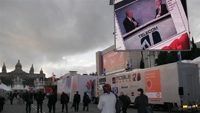Unicast versus broadcast mobile TV key dilemma for 2008 Mobile World Congress attendees

Broadcasters and mobile operators weighed in on the future of mobile TV at last week’s Mobile World Congress 2008 in Barcelona, Spain, debating the pros and cons of the predominant delivery mechanisms of such services.
At the “Mobile TV Technology Debate” and “Mobile TV and Video – Making it Happen” panel discussions, which took place last Tuesday and Thursday, respectively, executives from BBC Worldwide, Juniper Research, NBC Universal and Orange, among others, explored how the broadcast and unicast delivery methods could help or hinder the success of mobile TV services for broadcasters and operators.
Most of the panelists agreed that unicast services, typically in the form of streaming video and data delivered over a 3G network, are the most predominant type of mobile TV service being deployed today. These services are especially popular with mobile operators, because they can usually be run over an operator’s existing 3G network.
However, because unicast services are not easily able to support the access of the same video or data clip by multiple users simultaneously, and tend to degrade at high speeds and when used indoors, several of the panelists said it would be necessary to launch broadcast mobile TV services alongside unicast ones to provide the kind of user experience necessary to make a mobile TV offering successful.
Marc Fossier, executive VP and group CTO for France’s Orange, echoed a common thought among panelists when he said that while his company currently offers a 12-channel unicast mobile TV service, “we will need broadcast technology to devote to the most popular channels.”
To this end, Fossier said his company was focusing on the DVB-H and DVB-SH mobile TV technology standards.
Panelists seemed to agree that the best way to deliver mobile TV in the future would be as a combination unicast/broadcast package, with the unicast being used for interactive services as well as niche content, and the broadcast service supporting the most popular forms of content. Dr. Windsor Holden, principal analyst for Juniper Research, said it would be likely that by 2012, there would be approximately 320 million users of both unicast and broadcast-type mobile TV services, with many broadcasting services integrating unicast schemes in the same package.
The professional video industry's #1 source for news, trends and product and tech information. Sign up below.
Broadcast mobile TV however, presents its own set of challenges. Most of the panelists outlined the same key problems: a lack of compelling content and wide choice of channels for consumers, market fragmentation due to the large amount of competing broadcast mobile TV standards and the lack of prime UHF spectrum needed for such services in many countries.
Peter Mercier, head of the digital media division for the BBC Worldwide, noted that these were some of the reasons, along with the high cost of gaining rights to content, that his company would be unlikely to offer a stand-alone broadcast mobile TV service at any point in the future. He envisioned the future of mobile TV as being “one part of a multichannel world,” where broadcasters, operators and content owners would use mobile content primarily as a means to entice consumers to participate in other, more profitable services the company offers. On its own, he said, mobile TV would be unlikely to generate enough revenue to warrant the expense of deploying it.
On the other hand, Kevin Opi, senior VP of new digital media business for NBC Universal, said his company had seen some success with a 3G-based simulcast mobile TV service it deployed in Germany and Austria as well as the NBC2Go mobile TV service, which uses the MediaFLO broadcast technology in the United States.
Still, it did seem that the chief concern about broadcast mobile TV services was the business case, or lack thereof, for it. Holden said most broadcast mobile TV service deployments thus far have had “disappointing results,” generally because of the limited content and choice of channels the services can offer to consumers, resulting in subscriber bases that are too limited to support the cost of the service. One exception, he said, has been 3 Italia’s DVB-H-based mobile TV service, launched in June 2006 during the FIFA World Cup. According to 3 Italia, the service now has approximately 720,000 customers in Italy and covers roughly 70 percent of the country.
